Back
Powdermill Takes Wing
By Christine H. O’Toole
Bob Mulvihill opens a plain paper bag held closed
with a blue plastic clothespin, reaches inside, and produces
a small handful
of brown and white feathers. Lifting the bundle under
my nose, he says “now go ahead and blow.” So I
do. One breath exposes a bright pink bulge of skin on the breast
of a female
waterthrush resting in the ornithologist’s hand.
The
bird was bagged early this July morning at Powdermill Nature
Reserve, Carnegie Museum of Natural History’s Westmoreland
County field station. Her swollen, blood-rich brood patch
signifies that this mom has a nest of eggs to tend to, so
Bird-Bander-in-Charge
Adrienne Leppold quickly notes her weight, wing length, and
age (determined by close examination of her wing plumage),
gently slips a numbered band on her leg, and releases her
through a small window.
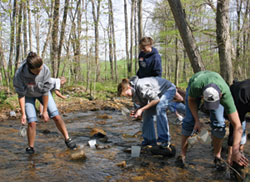 |
| Laurel Valley High School biology students collect invertebrate
samples in the crystal-clear waters of Powdermill Run. |
The warbler has just joined an international
club: She’s
one of 15,000 birds of 110 resident and migratory species
that the Powdermill Avian Research Center (PARC) will track
this
year. Started in 1961 by bird-bander-extraordinaire Bob
Leberman, who continues to work at Powdermill as an emeritus
researcher,
PARC has banded or recaptured a half million birds of almost
200 species—sometimes as many as 500 in a single
day. The thrill of an up-close encounter with all kinds
of wildlife—birds,
amphibians, and the occasional bear—draws nature
lovers of all ages to Powdermill year round for structured
learning
events or inspired field trips. The 2,200-acre nature preserve
located 60 miles from Pittsburgh is a living, breathing
science exhibit, and a resource for students of all ages.
“
At the museum, we study evolution and ecology,” says
Carnegie Museum of Natural History Director Bill DeWalt. “Our
Oakland collection is a history of life on earth, ideal
for learning about evolution. But Powdermill is alive.
It’s
a much more effective, exciting way to teach about ecology
and conservation.
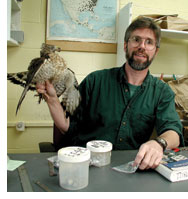 |
| Powdermill’s Bob Mulvihill,
Field Ornithology projects coordinator, holds the catch
of the day—a Cooper’s Hawk, which he bands
and releases moments later. |
With its scattered wooden cabins
for visiting researchers, towering trees, and magnificent
silence, the Laurel Highlands
research station seems more like a Brigadoon than a science
lab. It is, happily, both.
This year, the Reserve’s
profile is about to soar, as it seizes on the
public’s growing environmental awareness and its own
tremendous resources. A $7.5 million capital campaign, the
first in its 50-year history, will fund an endowment to expand
facilities, exhibits, and outreach. And a revolutionary expansion
design—including materials, energy sources, water, and
exhibits—will transform its nature center into as much
of a learning opportunity as the educational programs it houses.
Field and Stream Science
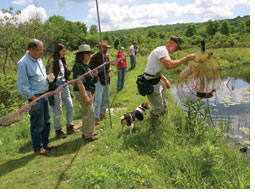 |
| Turtle trapping at the 2005 Bioforay |
David Hillenbrand, who joined Carnegie Museums of Pittsburgh
as its president in July 2005, says he was surprised by
all that Powdermill offers and excited by its great potential. “Like
so many people in the region, I wasn’t aware of the
fascinating living research being conducted at Powdermill
every day,” Hillenbrand says. “The scientific
study performed at Powdermill by resident and visiting scientists
is an extremely important complement to the work being done
by our scientists at the Museum of Natural History. And what
an amazing classroom for kids from throughout the region—many
of whom otherwise would never have the chance to catch
a close-up look at nature.” Powdermill welcomes about
12,000 guests of the non-feathered kind annually; 3,000
of them are students and summer campers
who explore the Reserve through hands-on activities in the
stream and attend classes at the Florence Lockhart Nimick
Nature Center. International students learn about Powdermill,
too,
through a project connecting schools in western Pennsylvania
with children in Germany and St. Croix. Developed by Powdermill
staff and funded by Kennametal, the curriculum allows children
to study local aquatic habitats, culminating in presentations
during a live videoconference (last year’s ended in a
spontaneous “SpongeBob Squarepants” singalong).
The collaboration gained Powdermill’s education program
top
honors in this year’s Western Pennsylvania Environmental
Awards.
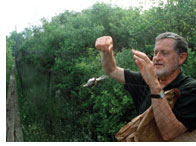 |
| Bird Bander Emeritus Bob Leberman
carefully extract a bird from a net for banding;
local high school students test water samples for
a biology project |
“
Everybody talks about distance learning, but very few places
are adept at providing content,” says DeWalt. “We
have lots and lots of content, and we’re able to
deliver that around the country and the world.”
The
Reserve has also stepped up efforts to engage adults. “We
have to focus on educating the decision-makers of today,” says
Powdermill Director Dave Smith. He notes that improving
the nature center’s “rather static” exhibits
as well as offering a sample
of the rich collections of the Museum of Natural History
will make Powdermill’s headquarters facility more of a destination
for families.
“
We need space to move forward,” says the genial director,
perched in a tiny cabin office by a thicket full of hummingbirds
and warblers. “The expansion will enable us to do more
with our education program. And it will give us lots more room
for lots more research.”

An architectural
sketch of Powdermill’s
expanded nature center.
“It All Started With Restrooms”
When the doors to Powdermill’s expanded nature center
open next summer, visitors will find the barn-like structure
totally transformed and environmentally friendly. A new welcome
center, temporary and permanent exhibits, expanded classrooms,
a Geographic Information Systems (GIS) lab, and office space
will all be heated through a geothermal system and insulated
with straw bales, while recycling wastewater to Powdermill-quality
purity.
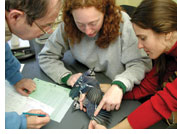 |
| volunteer Randi Gerrish, bird bander
Adrienne Leppold, and ornithologist Valerie Ojeda (from
Pategonia) compare the wing molts on an adult and an immature
Blue Jay |
In introducing the project to visitors, Smith shares
a current slide of a visiting school group posed in a long
line on the
lawn by the two restrooms. “This is, actually, the waiting
line,” he quips.
“
It all started with the restrooms,” says architect
Rob Pfaffmann, laughing, as he refers to the expansion’s “green” objectives.
Since Pfaffmann has incorporated environmentally responsible
and energy-saving features in all his projects, the restrooms
were his natural starting point. “We always have to
consider and mitigate man’s impact on the site,” he
explains.
The center’s ingenious solution to expand
those much-needed facilities is a marsh machine wastewater
treatment system.
The greenhouse of plants will absorb the wastewater from
the center’s new restrooms, scrub it clean, and pump
it into a terrarium/aquarium exhibit filled with Powdermill
fauna for
visitors to explore. The installation will be the only
one of its kind in the state. Surplus non-potable clean
water
will be reused in the washrooms or slowly leached into
a drip field
by the Reserve’s new Sugar Camp Trail.
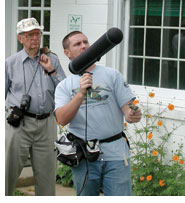 |
| Mike Lanzone, assistant coordinator
at PARC, prepares to release a warbler and record its flight
call. |
As Education
Coordinator Theresa Gay Rohall leads a visitor along the
trail, she pauses to shove aside a huge log blocking
the way. “Bears,” she proclaims calmly. She
continues uphill, pointing out deer and bear tracks while
praising Pfaffmann’s
design. “Few of the good nature centers in the country
now teach about the connection between building and the
environment,” she
says. “So we’ll have a tremendous teaching
opportunity, along with the chance to host many more students.
Right now,
we’re maxed out.” (Carnegie Mellon University’s
plan to build a demonstration solar house for a national
U.S. Department of Energy competition and then locate it
at Powdermill
will further the Reserve’s reputation as a demonstration
site for sustainable technologies.)
Other recycled materials,
like homosote roof decking made from newspaper, will complement
the interior with plenty
of natural
light. “When you look up, it will be like looking
through the forest,” says Pfaffmann. Digital controls
will minimize energy use. And, in keeping with the Powdermill
ethic that “bird
safety comes first,” angled glass walls and other
protection will shield birds from collisions. Microphones
and live Web
cams may allow human visitors to eavesdrop on the world
outside.
Information is Power
Powdermill’s expansion got a big jumpstart in 2005 with
a $3 million grant from the Richard King Mellon Foundation
to be used to build the nature center addition, which will
break ground September 10. Earlier this year, a Heinz Endowments
grant of $2 million—in honor of its late board member
William H. Rea and his deceased wife, Ingrid, both devout environmentalists
and longtime Powdermill supporters—created two new research
posts: a conservation biologist at Powdermill and a herpetology
curator at the museum.
Smith, who joined the Reserve in 2003,
heads Powdermill’s
small but passionate group of young staffers. Joe Stavish
is one of them.
On this magnificent summer day in July, Stavish
is literally knee-deep in the rushing Powdermill Run. “Trout
love these fish, and they’re a great water quality
indicator,” the
assistant education coordinator says admiringly, as he
scoops up an inch-long mottled sculpin in a mesh strainer.
While
Powdermill’s
original 1,160 acres, donated by the Mellon and Scaife
families in 1956, have doubled over the past few decades,
the staff
who lovingly use the land as their research lab and education
center still number only nine full-time employees. They’re
supported by numerous part-time staff, research associates,
and volunteers. “Powdermill’s volunteers are
making a tremendous impact on the life of the Reserve,” notes
Cokie Lindsay, operations coordinator at Powdermill. “We
regularly receive calls from enthusiastic people who want
to offer their time and expertise to help. The work of
these dedicated
and talented volunteers ensures that Powdermill will continue
to thrive and grow.”
Mulvihill, a walking encyclopedia
of avian knowledge, is the most senior of Powdermill’s
research staff. He began volunteering at Powdermill’s
Avian Research Center as a Pitt undergrad in 1978 and joined full-time
in 1983. He currently serves as the coordinator of Field
Ornithology Projects. Studying
the effects of environmental pollution on bird breeding is one of PARC’s
power alleys, and Mulvihill is the head information power broker. A decade
ago, he launched what is now a long-term study to assess the effects of
acid pollution in Laurel Run on the Louisiana Waterthrush.
“
The Louisiana Waterthrush is a beautiful case of a bioindicator,” offers
Mulvihill. His team of researchers has painstakingly tracked the number
of waterthrush nests in the banks along Laurel Run, which has high levels
of acid
mine runoff, and then compared that data with the same information collected
at nearby Powdermill Run, a near-perfect freshwater creek. “When
waterthrush density and productivity increase to levels like we observe
in Powdermill Run,
then we’ll know that remediation efforts have suceeded in restoring
normal ecological functioning of Laurel Run,” Mulvihill explains—for
not only the waterthursh but all of the wildlife that call the stream
home.
According to C.J. Ralph, a research wildlife biologist with
the U.S.
Department of Agriculture’s Forest Service, who earlier this year
solicited Powdermill’s
help in an avian flu monitoring project for the U.S. government, “Powdermill’s
big power is that it has the best past and present data…at a single
station of anybody in North America.”
Powdermill Goes High-Tech
Throughout the summer of 2006, interns Lauren McFarland and
Michael Baker could be seen stalking the Reserve from dawn
to dusk, toting clinometers, densiometers, digital cameras,
and global positioning systems receivers. Their exacting
explorations are a first step in the challenging process
of creating a detailed, layered, digital map of Powdermill.
Following a precise 20-meter grid established by Geographic
Information Systems (GIS) Specialist Trish Miller, which
is overlaid on the entire acreage of the Reserve, the interns
have captured data on vegetation types, canopy density, species,
streams, and wetlands boundaries, coordinated that data with
exact points of latitude and longitude, and transferred it
all into a digital Powdermill map.
Says Miller, “Now
we can create a gigantic database of everything at Powdermill—birds,
amphibians, and the crane flies that Chen Young (invertebrate
zoologist at the Museum
of Natural History) is studying.” The expanded GIS lab
will move into the Reserve’s renovated Rea Cabin this
month.
Miller shares a computer-crammed office with her husband,
Powdermill Ornithologist Mike Lanzone, often times joined
by their infant
daughter Phoebe. Lanzone’s specialty combines the low-tech
with the high-tech. Assembling inexpensive digital microphones,
he records bird calls during nocturnal migrations. “We’re
watching with our ears,” he explains. “Bioacoustics
helps us study more birds than those we can sight or band
by day.” He identifies species’ calls by comparing
them to recordings, displayed on the computer as sound waves. “If
we detect significant changes year-to-year in the species
composition or total number of birds recorded during migration,
this will
serve as an early-warning system prompting biologists to
search for possible enviornmental causes.”
Not far
away, in another cramped office, Mulvihill leads the research
for the 2nd Pennsylvania Breeding Bird Atlas,
the
first state breeding atlas in the country to take full
advantage of digital technologies such as GPS, GIS data, web-based
data entry, and real-time display of results. Already,
2,000
volunteers
have logged their sightings online to help create the amazingly
expansive database, which will be used by natural resource
agencies, land-use planners, and local and state governments
to promote bird conservation efforts.
To Smith, Mulvihill,
and their team, Powdermill’s planned
expansion is all about being able to more effectively
translate—for
the rest of us—the valuable and extensive scientific
information that is Powdermill’s treasure chest.
The result: The communities Powdermill now serves will
grow, and
their members will all gain a better understanding and
appreciation for the beauty, diversity, and fragility
of their everyday
world.
Mulvihill likes to share a quote from John E.
Guilday, a former vertebrate paleontologist at Carnegie
Museum,
who
penned an
essay about Powdermill in 1958. Entitled “Time
and Powdermill,” it
closes with a sentence that, for Mulvihill, sums up this
scientific Brigadoon’s magic:
“
The forest at Powdermill will …be passed on to future
generations of scientists who may catch a glimpse of
the effects of years, of centuries, upon a land held for
the study of the
slow, inevitable cycles that march and countermarch across
its face. This is the unparalleled offering of the Reserve—the
gift of time.” On the occasion of its 50th anniversary,
as Powdermill takes wing, the value of that gift could
not be more
clear.
Back | Top
|